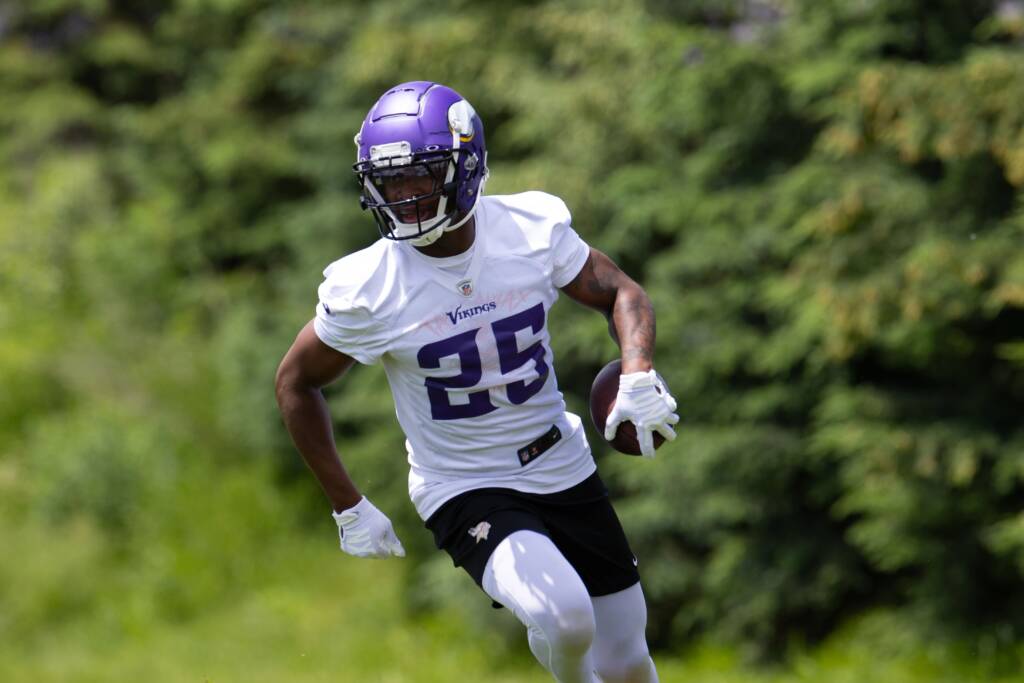The NFL draft has come and gone. The Minnesota Vikings took 10 players, including one running back. However, Ty Chandler, Minnesota’s fifth-round pick, won’t be a threat to unseat Dalvin Cook anytime soon. But does that mean that the Vikings plan to hold on to their $63 million back throughout his contract? Most analytically focused front offices have moved away from expensive running backs.
It felt like Justin Jefferson was the only player with any job security after Kwesi Adofo-Mensah and Kevin O’Connell took over. After some contract restructures and signings, we know Kirk Cousins and Adam Thielen are part of their future. However, that does not protect everyone from the business of the NFL. Cook is a borderline top-five running back in the NFL and an essential part of the Vikings’ offense, but that doesn’t completely take him off the market.
In the fall of 2020, Rick Spielman and Co. offered Cook a five-year, $63 million contract extension, with $28 million guaranteed. Just under two years later, Minnesota has a different general manager and head coach who may value running backs differently.
First off, the ramifications of trading Cook this offseason need to be examined using a cost-benefit analysis of Minnesota’s current running back situation. In 2021, Cook was more than sufficient for Mike Zimmer’s ground and pound/play-action scheme.
In 13 starts, Cook ran for:
- 1,159 rushing yards
- 4.7 yards per carry
- 89.2 yards per game
- 6 total touchdowns
Alexander Mattison would be his most likely replacement if the Vikings were to trade Cook this offseason. Being second fiddle to a three-time Pro Bowler generally hinders a player’s output, but Mattison found ways to show his value when Minnesota gave him the opportunity.
In four games as a starter last year, Mattison was excellent for the Vikings:
- 356 rushing yards
- 4.2 yards per carry
- 89 yards per game
- 4 total touchdowns
There are many similarities between Cook and Mattison when you compare their numbers from 2021. The only glaring difference is that Cook started nine more games than Mattison last year and that Cook costs the Vikings a lot more than Mattison.
Cook is scheduled to make $8.3 million in 2022, $10.4 million in 2023, $11.9 million in 2024, and $12.9 million in 2025, for around $43.5 million in total. Mattison has yet to reach any long-term agreement with the Vikings. But for reference, Mattison made $850,000 last year and is set to make $965,000 in 2022.
The two running backs are nearly identical when looking at their statistics as starters. Looking at the disparity in salary, it is extremely hard to justify why the Vikings should pay Cook almost nine times the amount they will pay Mattison in the upcoming season. That also doesn’t include over $35 million Cook is set to make after this year and the previously mentioned guaranteed $28 million.
Most successful organizations do not sign running backs to large contracts. As the great philosopher George Santayana once said, “Those who cannot remember the past are condemned to repeat it.” Luckily, Adofo-Mensah and O’Connell have the opportunity to look at previous transactions to support this idea further and may decide to act on it this offseason, when Cook is at peak value.
Why aren’t teams paying running backs?
First is the current state of the running back market. The supply for good running backs coming out of the draft and in free agency is at an all-time high. There’s no reason to commit to an expensive running back when you can get an adequate replacement for under $1 million per season. Why pay for Cook when you’ve got Mattison behind him on the depth chart?
Secondly, running backs tend to peak earlier in their career than other positions because of the physical demand of being an NFL ball carrier. Running backs are almost always more productive on their first contract, which especially burns franchises that give long and expensive extensions to them. Examples of this are the Los Angeles Rams replacing Todd Gurley with a plethora of young talent, the Ezekiel Elliott and Tony Pollard situation, Le’Veon Bell with the New York Jets, and David Johnson in Arizona/Houston, etc. These running backs had as good, if not better, starts to their career than Cook. None of them lived up to the dollar amount their second contract was worth. In fact, all of these players significantly regressed almost immediately.
In many situations, teams dish out large sums of money to only a handful of players like quarterbacks and pass rushers because they are just getting more expensive as time goes on. Therefore, franchises that pay their running backs often end up having to give up a star player at a different position like wide receiver. That could be the case for Minnesota if Cook’s contract continues to eat away at cap space in the upcoming years. Along with Danielle Hunter’s hefty contract and Jefferson’s likely historic extension, the Vikings could run into serious problems.
The new Vikings front office would be making a financially conscious decision while simultaneously maximizing the return on investment by trading Cook at his peak value this offseason. It’s a big decision to make, and thus far, there is nothing directly hinting at the organization looking to shop Cook, but it would hardly be a surprise if they did.

